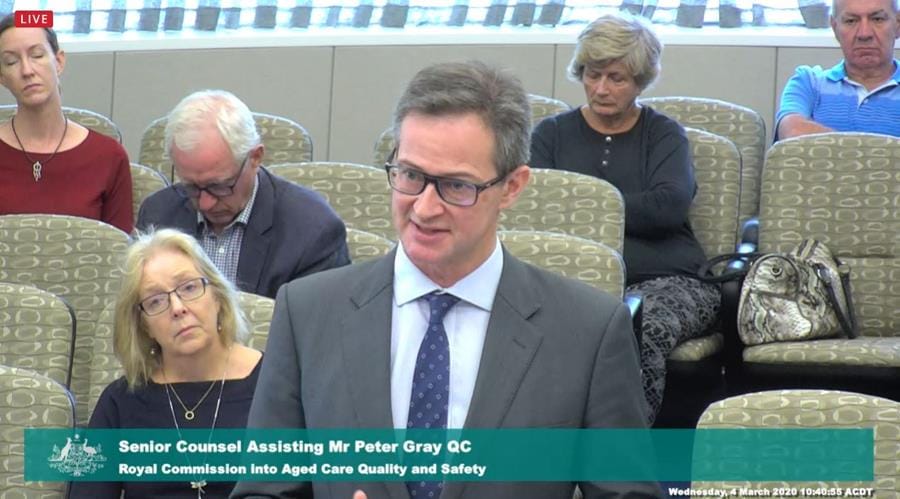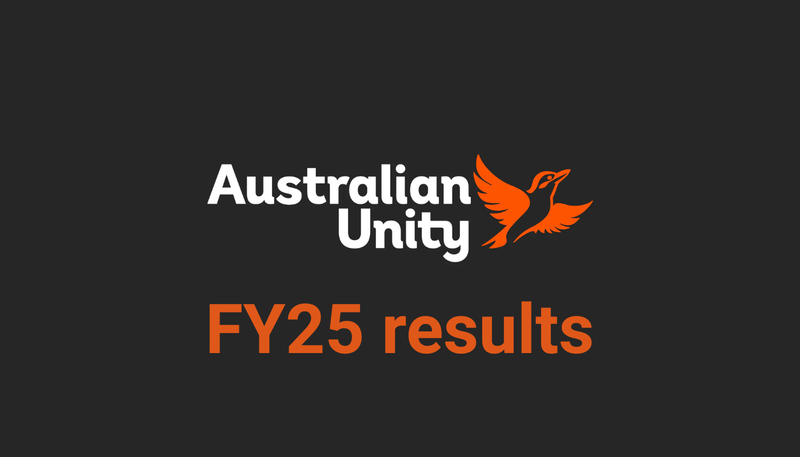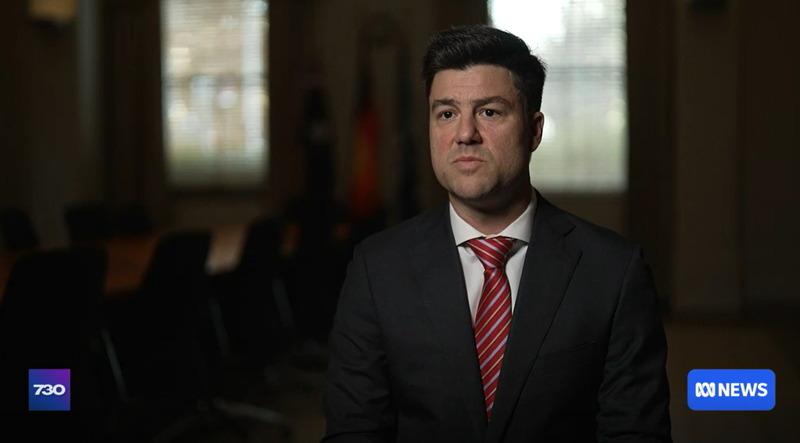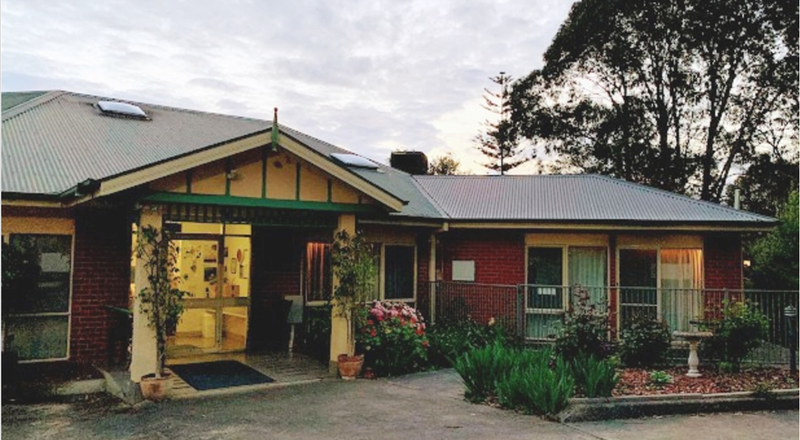Uncapping supply, immediate access to supports and a new “care finder” workforce: Senior Counsel outlines ideas for redesign of aged care system – as Commissioner Pagone calls on sector to “fully engage” with Royal Commission
You can read the full 75-page submission here

Senior Counsel Assisting Peter Gray QC (pictured above) has advocated for the uncapping of aged care supply, better pathways into services and a new body to lead “care finding” and assessment – but backed away from the Commissioners’ proposal in their Consultation Paper 1 for the separation of care and accommodation in residential care and funding tied to the consumer in the Counsel Assisting team’s submissions on the redesign of the aged care system. You can read the full 75-page submission here. Speaking for just over an hour, Mr Gray said the Counsel Assisting are not proposing the three ‘entry level support’, investment’ and ‘care’ streams and agnostic funding outlined in Paper 1 go ahead. Reflecting on the 183 submissions received on the Consultation Paper, the Senior Counsel also seemed less committed to the recommendations he was making than Senior Counsel Assisting Peter Rozen QC was at the workforce hearing on 21 February – repeatedly calling for responses from Government, providers, peaks and the public on the proposals being made.
“These submissions are not our final recommendations to the Royal Commissioners about program design and we invite further public submissions in response to these submissions,” he said.
Mr Gray was also careful to emphasise that many of the changes would require a transition strategy and, in some cases, a staged transition over the medium- to long-term – signaling the “fundamental overhaul” of the system will take years to completely roll out.
“It is imperative that continuity of services be maintained while reforms are implemented,” he stated. “Although the reforms are urgently needed, adequate time must be allowed for key factors in the system to be planned for and for transition to a clearly defined set of outcomes.”
However, the Senior Counsel was clear that if implemented, the changes would lead to “significant improvements” in the way aged care is subsidised and provided to older Australians. He highlighted the areas that the Counsel Assisting team believed must change:
Access to aged care should be determined by need:
“People assessed as having needs justifying higher level of care at home should not have to wait until a rationed package becomes available,” he said. “People receiving care whether at home or in residential facility should have confidence that their provider is funded to provide the care that is necessary to meet their assessed needs.”
Mr Gray said this would be achieved through two changes: first, linking funding to levels to the actual costs of care. This funding would be set by an independent authority and updated regularly with providers required to account for their expenditure on care. The second step would be to fulfil David Tune’s recommendation and uncap supply on aged care packages and beds. Mr Gray acknowledged this uncapping may need a staged transition, depending on regional conditions, and in advance of these changes, the Government would need to:
- Put “robust” arrangements in place to ensure providers are held accountable for their expenditure on care
- Determine the demand for aged care services for budgeting and funding purposes
- Make arrangements to avoid “bottlenecks” in access to services eg grow the workforce
Reorientate the system towards wellbeing and independence:
Mr Gray said older Australians should be entitled to care that not only meets their clinical needs, but also enhances their wellbeing and quality of life and provides support for their informal carers. This would require comprehensive assessments to determine a person’s need for care, he added, plus care planning and funding for social supports at all stages of the aged care journey through to palliative care.
“This, together with funding matched to assessed need and accountability for expenditure on care, would help to drive a shift in the system from its current state of rushed task-based care – I don’t say that’s inevitably and always the case but in many cases the evidence before you shows that that is the case – in the direction of high quality relationship-based care supported by funding, for high levels of skill staff.”
Access through care finding and case management:
Mr Gray argued the new system needs to provide older people with a much easier path to access services with multiple ways to be referred to aged care services – including through GPs – with face-to-face assistance led by “care finders” who would also provide ongoing case management. This care finding and assessment would be coordinated under one banner – “to minimise confusion” – in addition to the My Aged Care call centre and website.
“Whether the banner for the care finding and assessment function should be called My Aged Care is an issue for further consideration,” he noted. “But our preliminary proposal is that it should be different.”
This new workforce of “care finders” would operate throughout Australia on a local basis, providing people with advice on care options, arranging basic supports on an interim basis and organising assessments. This change would also require performance or ‘star ratings’ about different services for people to weigh up their options, Mr Gray added.
Innovative accommodation:
The Senior Counsel said there should be incentives provided for operators who develop innovative accommodation options that are less institutionalised than ‘big box’ aged care facilities.
“This may involve assistive technologies and this is particular significant in the area of apparent demand for flexible and innovative supported accommodation in which more complex and intensive home support and care can be provided.”
Data collection and evaluation:
Mr Gray said this was essential to improving quality of care, particularly around medication management and preventive care.
“The data regime should be designed to take full advantage of available information communications technology and to minimise administrative burden in the collection of the data.”
This data should then be regularly evaluated at both the provider and system level, he added.
Local strategies:
The Senior Counsel also said there was a need for strategies to improve access in rural and remote areas with the involvement of local governments, the community and diverse needs groups, plus the new care finder workforce. Mr Gray then detailed the elements of the existing system that the Counsel Assisting team believes should stay in place. Most were fairly straightforward, such as aged care should primarily be funded by the Government (though he acknowledged consumers will continue to make “substantial contributions” to their care) and should continue to be provided by a mix of approved For Profit, Not For Profit and Government providers. There were a surprise however, namely that residential aged care should continue to be bundled with no separation of care and accommodation. There was also recognition of the need for more care settings outside of the traditional aged care facility. Mr Gray said that residential care will play a role, but “there might be proportionately fewer people residential facilities over time and there should be growth in the proportion cared for at home or in the community or in more flexible forms of supported accommodation.” Noting that the aged care system is far broader than the program he had just outlined, the Senior Counsel then took the Commissioners through Counsel Assisting’s written submissions and the proposals they are making in more detail:
Part 3: Life planning
Four pages are dedicated to the need to plan for the ageing journey well before a person requires aged care services. This includes encouraging people to create advanced care directives, promising positive ageing, addressing health literacy and involving the person’s GP wherever possible in this planning. The Senior Counsel in particular emphasised the need for financial planning including housing options – in short, that the Government should get people thinking about where they will live and how they will pay for care.
“Our proposal here is that the Australian Government, in cooperation with other levels of government, should fund and support education and information strategies to improve public awareness of resources to assist people to plan for ageing and potential aged care needs,” he said. “These strategies should support a continuum of planning for ageing including consideration of the limits of health care preferences for care and a consideration of finances, housing and social engagement.”
Part 4: Information and contact points
As people move close to needing aged care services, Mr Gray said there needs to be a ‘no wrong door’ policy for accessing services with referrals from GPs, social workers, local government and others made possible. Improved information would also be made available more widely with no more reliance on My Aged Care to access care.
Part 5: Care finding and case management
Under the Counsel Assisting’s 12-page proposal, older people would be offered personalised help including face-to-face assistance and ongoing case management to navigate the system. This help would be provided through a team of “care finders”, who would have local knowledge and be able to give advice on options and arrange basic supports. They would also be able to provide ongoing case management, depending on the preferences of the care recipient. This new workforce would be controlled by a new organisation staffed by Australian public service employees who would either recruit the care finders directly or commission local governments to supply the workforce or a combination of both. The care finders would also work closely with assessment teams, who would fall under the same umbrella organisation.
Part 6: Informal carer support services and respite
With the Royal Commission looking to keep people living at home as long as possible, nine pages of the submission is devoted to supporting informal carers. These supports could be arranged through the care finders or community hubs, Mr Gray stated, with the comprehensive assessments for aged care to also take in the needs of the carers and their need for support services, such as counselling, training and especially respite.
“Respite should be overhauled by substantial increase in the scope and scale of respite and its ready availability and the availability of different kinds of respite and an appropriate framework of incentives for providers of respite.”
The Counsel also pointed to the need to link the Department of Social Service’s Carer Gateway to access to respite in aged care so carers don’t have to coordinate care over both systems.
Part 7: Assessment
Six pages are spent outlining the Counsel Assisting’s proposal for assessment, which centres on assessment teams that would operate across Australia as a single, national organisation (at odds with the Government’s now-paused plans for assessment teams fielded by multiple organisations). These teams would have experience in the range of conditions found in aged care and be able to “scale up” their resources depending on the needs of the person being assessed (presumably, meaning a geriatrician would be called in for complex care needs, a physiotherapist for mobility issues etc). These assessments would also rely on any current assessments by the person’s GP or other health professionals and also assess the carers.
Part 8: Wellness, reablement and rehabilitation in aged care
Commissioner Lynelle Briggs’ mantra. These six pages propose the Government fund the delivery of wellness, reablement and rehabilitative services.
“The type of services may include but not be limited to occupational therapy, physiotherapy, nursing support, personal care, nutritional interventions, medication reviews, provision of technologies to help with day-to-day activities, minor home modifications and measures for addressing loneliness.”
These services also be provided to older Australians regardless of whether they are living at home or in residential care and regardless of their cognitive status – an important point for people living with dementia, Mr Gray added.
Part 9: Diverse needs in aged care
Recognising again that meeting the needs of people from diverse backgrounds requires a “whole of system” approach, the Senior Counsel stressed the responsibility of Government in providing services that cater to people from diverse groups whether they are living at home or in an aged care setting – in just two pages.
Part 10: Home support and care: additional points
Mr Gray pushed for the Home Care Package Program and the Commonwealth Home Support Program (CHSP) to be streamlined into a single service with a single assessment as soon as possible (another David Tune recommendation) with funding determined by need and not “rationed”. Assistance in accessing these services would be provided by the care finder, who would also provide case management with the option for people to self-manage home supports where there is a “sufficient market” of services. This option could also be extended, the Counsel said, as discussed in the four-page section.
“It may be appropriate that all of personal care available for people in their own home could be self-managed. An important safeguard in that respect is that people should be given this option for self-management provided they’re assessed by the assessment process as being capable of self-managing and that it’s appropriate for them to self-manage their own care.”
Part 11: Innovative accommodation models
The Senior Counsel called for the Government to provide incentives for innovative accommodation models – particularly those that let older people live in “home-style” accommodation – over four pages.
Part 12: Residential care: additional points
Just four pages but the most proposals. Mr Gray said residential care should be funded under an “appropriate” case mixed model based on an individual assessment undertaken by the assessment team. Funding would also be linked to the actual costs of care and include funding for basic social supports such as transport and social activities.
“That is currently a gap in funding for residential care and it needs to be addressed,” he explained.
Providers would be held responsible for care planning and coordination and have an obligation to seek a reassessment if a care recipient’s circumstances changes. The Counsel Assisting also recommended performance-based loadings for providers who offer reablement as well as those who cater to people with diverse needs and from CALD backgrounds. Loadings would also apply in rural and remote areas and in very thin markets, the Government should guarantee funding in return for a provider becoming a ‘provider of last resort’, Mr Gray added.
Part 13: Standardised data collection and analysis
The final five-page section lays out the Counsel Assisting’s proposal for the Government to implement a standardised data collection program, based on the ‘collect once, use many times’ principle.
“The data to be included in the program should include, firstly, service usage data and a full range of service categories relevant to aged care, a comprehensive range – this is next – a comprehensive range of health quality and safety health … data including medication data, data about diverse needs, quality of life metrics, data about transitions and interfaces with the health system in each jurisdiction.”
Critically, Mr Gray said the Government needs to collect and analyse data to forecast demand for aged care (the lack of Government data being a point that has been made throughout the Royal Commission). This information should then be linked to other agencies that provide services related to aged care, including the Departments of Veterans’ Affairs and Social Services.
Much work to be done – including on funding and financing options
Finally, the Senior Counsel turned to the work that must be done to implement any of these reforms, pinpointing a range of areas that need to be addressed.
“Closely interdependent areas of inquiry include defining and measuring high quality care, public transparency of provider-related information including performance, access for groups with diverse needs including Aboriginal and Torres Strait Islander people, quality assurance in commissioning of providers in different forms of commissioning, quality and safety regulation, the workforce, research, technology and innovation, funding and financing options.”
Mr Gray particularly dwelt on the funding reforms required, again asking for responses to the funding issues outlined in the submissions including funding for carer supports and respite, reablement and residential care. He also acknowledged the elephant in the room: that all of these proposals will require greater levels of funding – and improved systems for providing that funding.
“Merely providing greater levels of funding is not the only answer,” he added. “Great care needs to be given to designing mechanisms that provide appropriate incentives for high quality care and which impose, in our submission, appropriate accountability for the use of public funds.”
Questions to be addressed in response to Counsel Assisting’s ideas
The Counsel also posed a number of questions for those responding to the proposals to consider including:
- Can a case mix model be applied outside a residential care setting and, if so, can it be applied both to basic home supports and also to higher levels of home care?
- Can and should there be separate funding for respite? And for education counselling and other support services for informed carers?
- How should preventive rehabilitative and restorative interventions, with particular responses to episodes of deterioration in a person’s health be funded separately from the person’s funding for ongoing care?
- Should a new case mix model such as the Australian National Aged Care Classification (AN-ACC) be applied in the residential care setting?
- Should the levels of case mix funding be calculated with the method for mandating case mix adjusted staff ratios which are recommended in the Counsel Assisting submissions on workforce?
- Should residential care case mix funding for ongoing needs be accompanied by funding for ongoing social supports?
- Should financial reporting of expenditure by care providers on the costs of care be required and should adjustments to future payments apply if they over- or under-spend?
- How should basic supports in the home be funded? Should direct grants continue to be used and in thin markets should direct grants be used for both basic supports and more complex needs?
- And should the programs other than the Commonwealth Home Support Program (CHSP) and the home care packages program and the residential aged care program continue as they are or are changes needed?
Senior Counsel pleads for submissions on redesign of system
Lastly, the Counsel returned to the submissions on Consultation Paper 1 and alternative models to the Commissioners’ model, singling out Professor Kathy Eagar (who led the research for the Royal Commission’s first research paper into residential care staffing levels in Australia and how they compare to the rest of the world) and her expanded submission which outlines four streams of care with different funding approaches. This includes direct grants for age-friendly community services and basic home supports and a case mix funding model for more complex home care and residential care. Mr Gray also pointed the Commissioners’ attention to Catholic Health Australia’s submission which advocates for separate funding for residential care and home care and for funding to be allocated by a level or package – a complete contrast to the Commissioners’ original paper that shows the new model is still very much to be decided.
“We invite further submissions from the public about institutional, market structures and delivery models best suited to the new program design that I have outlined in this address and about any required modifications needed to align with optimal institutional structures and delivery models,” he concluded.
Commissioner Pagone calls on sector to “engage fully”
With the submissions wrapped up, it was left to Commissioner Tony Pagone QC (pictured above) to close the proceedings – and he had an important message for the sector which providers should pay close attention to.
“The Commissioners have heard and seen over many months some deeply concerning neglect, whether institutional or governmental, clinical, emotional or personal, and our focus has moved now squarely upon what to recommend to give Australians the aged care that we deserve and that will do our country proud,” he stated.“We have heard anecdotally that some of the participants in the sector have been reluctant to engage fully with the Commission, and we urge that any that may feel reluctant overcome their reluctance and engage fully. The process we have taken, as you have seen, both in the submissions that were made to us by Mr Rozen on 21 February and those which you have heard today are that we are being open to the public about our thinking,” he added.
The Commissioner also made one final bid for providers to have their say on the future of the system.
“Our message in Counsel’s Assisting’s submissions of today and also those in Mr Rozen’s of 21 February is we are actively considering specific proposals,” he underlined. “Those assisting us have read your submissions and have taken them on board to the extent that they are consistent with the views that they currently wish to put to us. They have told us where their recommendations are currently and we ask now for your detailed responses to that. We are listening to you and we will continue listening to you. We urge you, therefore, that you engage with us meaningfully so that we can continue to listen and produce the best outcome that we are able to produce.”
You heard it then. It is time to step up and speak out – or risk not being part of the conversation. A lot to digest – so I will be back tomorrow with further analysis of the Counsel Assisting’s written submissions.





